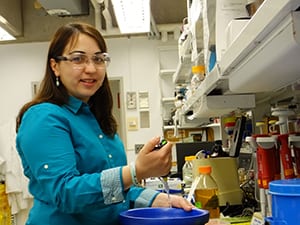News
All’s Fair in Love and War (on Insects)
 Patricia Pinheiro was drawn to the study of insects like a moth to a flame.
Patricia Pinheiro was drawn to the study of insects like a moth to a flame.
As a graduate student in the Cornell Entomology Department and a member of Assistant Professor Michelle Cilia’s lab, Pinheiro studies insect pests that feed on plants and transmit plant diseases.
“In my undergrad work I studied agronomy and I had lots of opportunities to work with pest management. I fell in love with insects,” said Pinheiro. “I think it’s really amazing how they adapt.”
“I study them to control them,” she laughs “but I like them.”
Pinheiro hales from Goiana, Brazil. She attended the University of Goias for her undergrad and attained a master’s at the University of Brasilia. Currently, Pinheiro is an employee of EMBRAPA—the Brazilian equivalent of the USDA—and the agency funds her doctoral studies. After being promoted to a principal investigator position, she started a PhD at BTI after reading all of Cilia’s papers and being fascinated with her research.
Now, three years deep into her doctoral work, she’s researching the green peach aphid, Myzus persicae, and how switching its plant host affects its ability to transmit Potato leafroll virus. By comparing all of the proteins that the green peach aphids make when feeding on different plants—with and without the virus—she hopes to discover proteins in the aphid that are integral to transmitting the virus.
Because differentiating among the proteins that aphids make when feeding on different hosts generates mountains of data, she is also developing a pipeline to annotate which proteins she finds.
Pinheiro will present this work in June at the Arthropod Genomics Consortium Meeting in Manhattan, Kansas. She received the 2015 Rawlins Endowment Award from the Cornell Department of Entomology to fund her trip. Last year she won a USDA AFRI travel grant to attend the 2014 Entomology Society of America meeting in Portland, Oregon.
Experiments detailing the interactions among plant hosts, insects and viruses are already highly complex, but Pinheiro has also considered the effect of bacteria living inside the insects on virus transmission. She coauthored an article in Current Opinion in Insect Science, along with Cilia and two other collaborators, which appeared online in late January. The paper discusses the role of the endosymbionts—bacteria living harmoniously inside insect cells—in whether an insect passes on a plant virus.
“We’re giving our opinion about a very debated question in the field,” she said.
Previous studies had concluded that proteins, in particular one called symbionin, generated by certain endosymbionts in aphids help plant viruses to circulate through the insect and to be transmitted more efficiently to the plant. This type of interaction makes sense if the insect prospers by feeding on an infected plant, but if the virus harms the insect too—as some plant viruses do—then it is not in the best interest of the bacteria to help out the virus. If the insect dies, then its endosymbionts will perish as well.
More recent studies conducted in the laboratory of Angela Douglas, an entomologist at Cornell University, find that symbionin is not involved in virus transmission after all, and that it could only be found in the bacteriocytes, which are specialized cells that house the endosymbionts. Researchers in the Douglas laboratory didn’t find the protein inside other parts of the insect, where the virus would need to circulate to be transmitted to the plant. “Physically there would be no chance for the protein to interact with the virus,” Pinheiro said.
As often happens in biological systems, what actually occurs is probably more complex than it first appears.
“There might be a role for the endosymbiont in virus transmission, but it is more likely to be some indirect interaction, like influencing the plant behavior, or say, priming the plant to receive the virus.” Many studies have shown that certain insects fare better when feeding on infected plants.
“If the virus causes any benefit to the insect then this would indirectly benefit the bacteria as well, so one hypothesis could be that the three of them are in symbiosis,” said Pinheiro.
To investigate the nature of these interactions, Cilia and her lab members present a simple model in the paper that can estimate whether a bacterial symbiont is likely to be involved in virus transmission and to what degree.
“People can use the model to compare the contributions of the symbiont and the insect vector in pathogen transmission,” she said.
Pinheiro has one year left to finish her research before returning to Brazil where she will begin studies of a stinkbug species that is a major agricultural pest in Brazil. The genome of the insect is not yet sequenced, and she hopes to make connections with other researchers at the Arthropod Genomics Consortium Meeting who can help her create genetic tools for the pest. These tools could help her find better ways to protect plants from this insect that she finds so fascinating.

